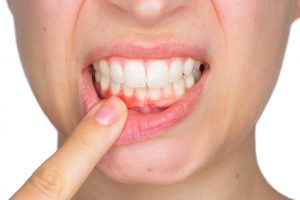 An alarming statistic shows that at least 85% of American adults have some form of gum (periodontal) disease, and nearly half of that population have a more advanced form of the condition. We uncover more about this prevalent dental malady, it’s different stages and how, in conjunction with your daily habits, your dentist in Dublin can help you prevent gum disease.
An alarming statistic shows that at least 85% of American adults have some form of gum (periodontal) disease, and nearly half of that population have a more advanced form of the condition. We uncover more about this prevalent dental malady, it’s different stages and how, in conjunction with your daily habits, your dentist in Dublin can help you prevent gum disease.
What is Periodontal Disease?
Periodontal disease is the inflamed state of your gums. The condition is brought on from what are the major antagonists of your oral health – bacteria.
They are always present in your mouth, but when you eat food, bacteria combine with the same and produce acidic secretions that bathe the enamel (the hard, outer surface of your teeth). Over time, cavities can develop, but the encroaching bacteria can also seep beneath the gums.
This can lead to periodontal disease, which develops in three stages.
Stage #1 – Gingivitis
The initial phase of periodontal disease is gingivitis, which can announce itself through swollen, irritated and easy-to-bleed gums. This is the ideal stage to identify and treat the condition because any damage done is still reversible.
Here are some common solutions your dentist may offer:
- To brush and floss more frequently
- To make improvements in your diet
- To make changes in how you perform oral hygiene
- To choose a toothbrush with softer bristles
Stage #2 – Periodontitis
If the early signs of gum disease are ignored, then it will eventually morph into a more advanced form called periodontitis. By now, there has been permanent damage incurred and the infection has begun to form pockets beneath the gums.
At this point, your dentist may recommend a scaling and root planing procedure, which cleans beneath the gumline to remove the bacteria that have collected. He or she will also smooth the surface of your teeth roots to prevent any new bacteria growth.
Stage #3 – Advanced Periodontitis
The most advance stage of periodontal disease is periodontitis, and at this point, more of the fibers, bone, connective tissue, and roots may start to dissolve, leaving your teeth vulnerable to falling out. If your condition is allowed to get to this level of severity, then surgery may be the only option.
How Prevention Saves Money and Time
By visiting your dentist every six months for preventive care, you can eliminate the chances of periodontal disease reaching its full and harmful potential. Since these visits are typically fully covered by insurance companies, you will have the opportunity to nip a developing problem in the bud without opening your wallet.
So to schedule your first preventive care visit, contact your local dentist today.
About the Author
Since graduating from The Ohio State University College of Dentistry, Dr. Eric Buck has been on a crusade against oral bacteria. He helps patients overcome these nemeses through educating them about how to take their oral care to the “next level.” Dr. Buck provides preventive care at Distinctive Smiles, and he can be reached for more information through his website.
